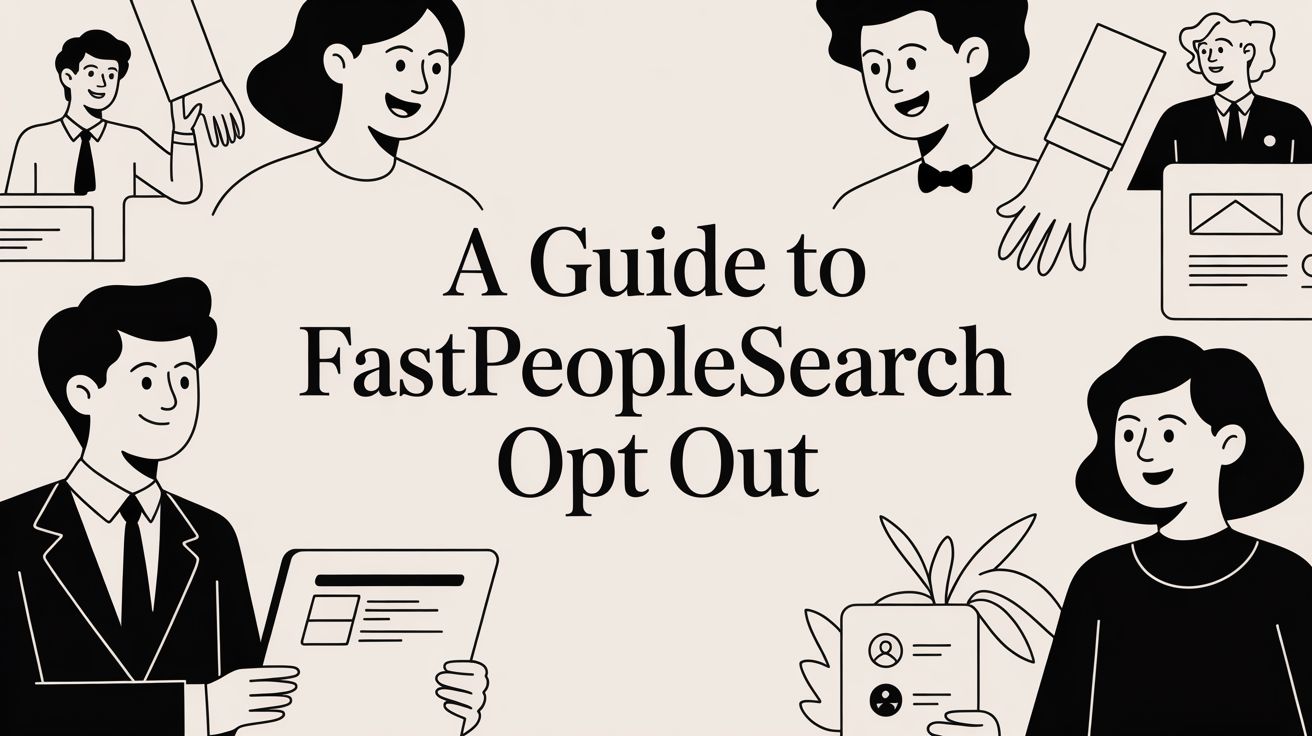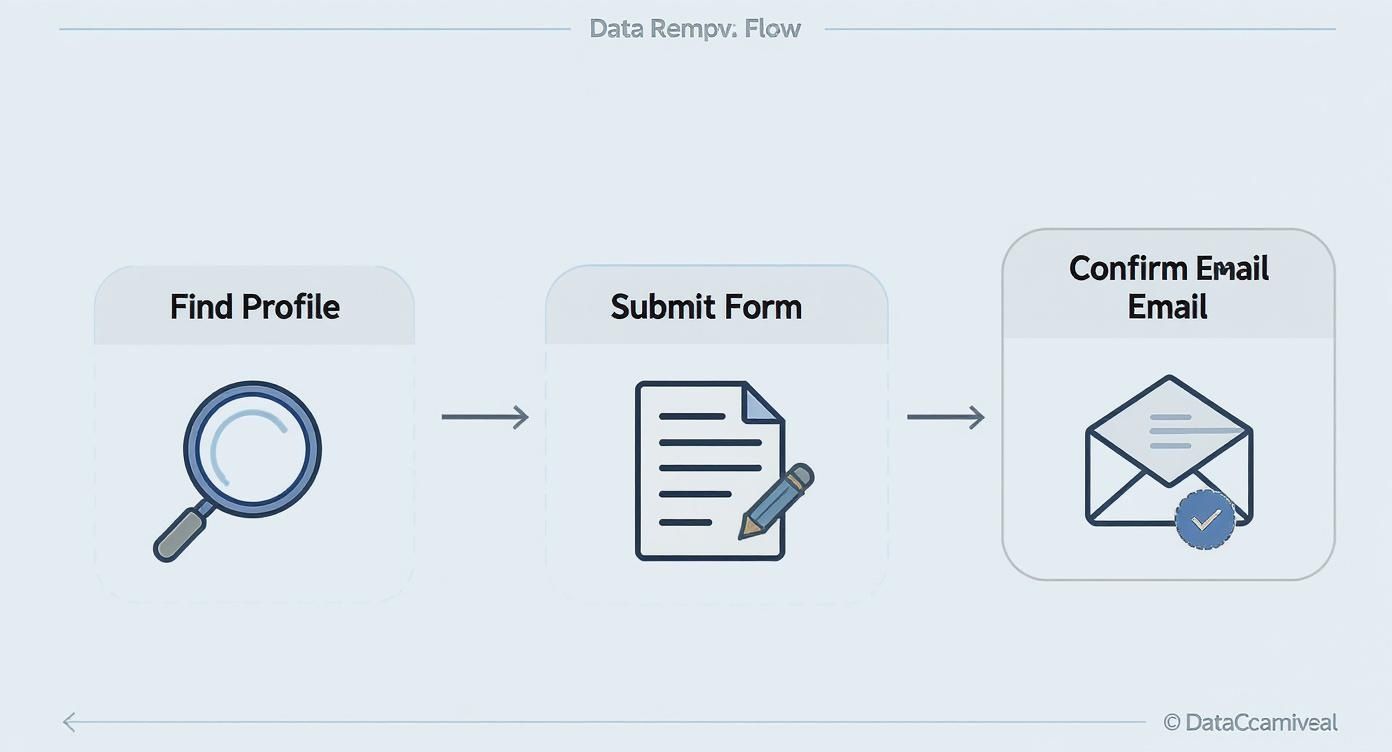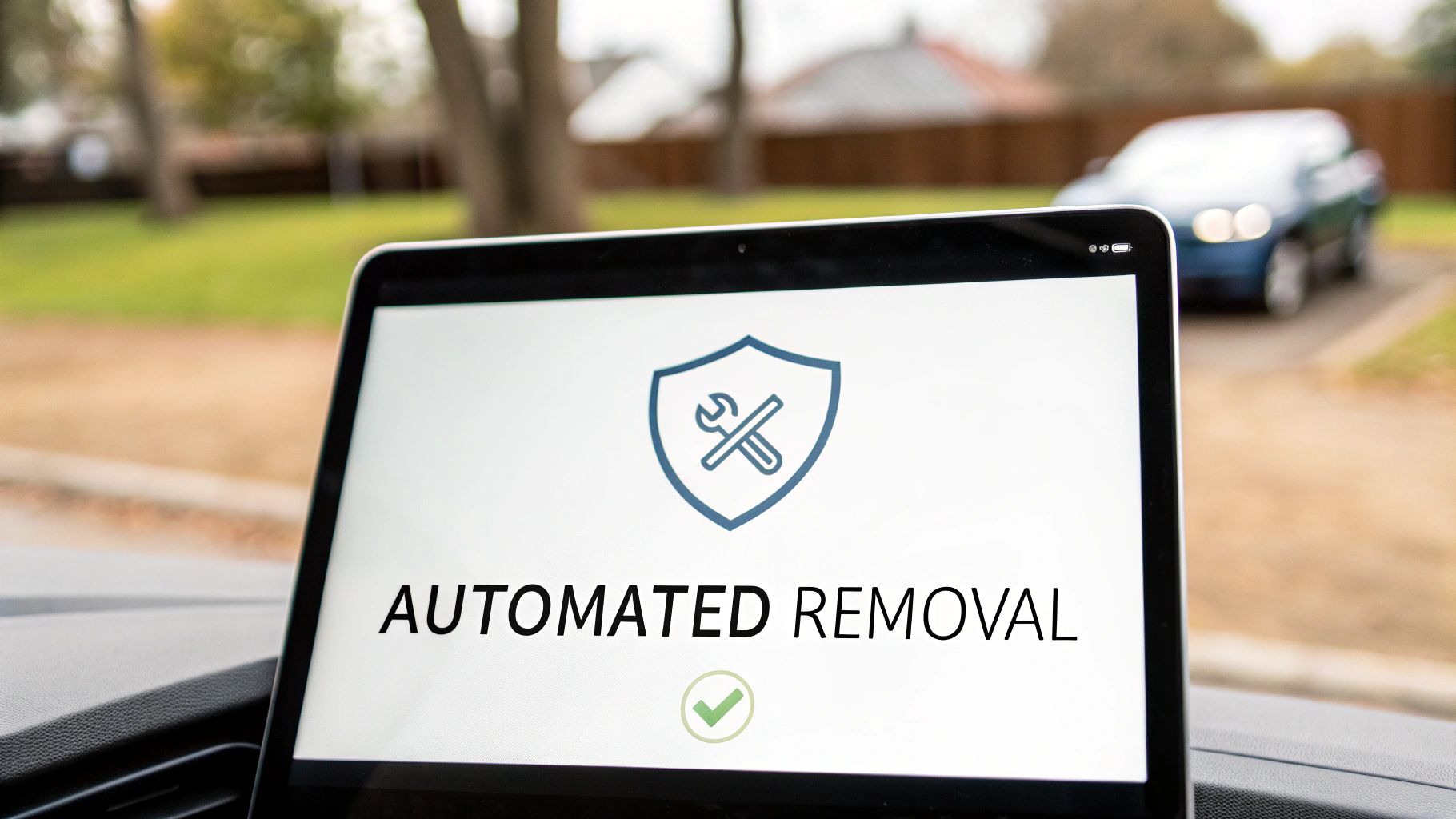
Finding your personal details splashed across a site like FastPeopleSearch can be a jarring experience, to say the least. But the good news is that getting your information removed—the fastpeoplesearch opt out—is a process you can handle yourself. It really only takes about 10 minutes to get the ball rolling.
Where Does FastPeopleSearch Get Your Information?
If you're asking yourself how your full name, every address you've ever had, and a list of your relatives landed on a website you've never even heard of, you're in good company. FastPeopleSearch is what’s known as a data broker. Their entire business model is built on collecting, packaging, and displaying information they pull from public sources. This isn't a sign you've been hacked; it's just how they operate.
These sites are constantly scraping data from a huge number of public databases, including:
- Property Records: Think home sales, deeds, and property tax info.
- Court Filings: Details from civil and criminal court dockets are often public.
- Voter Registration Lists: Your name and address are typically public records.
- Phone Directories: Old-school phone books and modern digital listings.
All these scattered bits of your life are then stitched together into one neat, searchable profile. The real problem here is consent—or the lack of it. Your data is collected and published without you ever giving the okay, which opens the door to major privacy risks. Anyone with an internet connection can dig into your personal history, and that information can be used for anything from idle snooping to much worse, like stalking or identity theft.
A Look at the Platform's Reach
Launched back in August 2017, FastPeopleSearch has become one of the biggest people search sites out there, mainly because it's completely free. Plenty of data brokers exist, but the no-cost model makes it incredibly easy for anyone to access sensitive details. Thankfully, the manual opt-out process is your best defense, and once you submit a request, it usually takes 24 to 72 hours for your profile to disappear.
Here's a look at the site's simple search interface, which is all someone needs to start digging with just a name or phone number.
This no-frills design really highlights its purpose: to provide fast, easy access to personal data.
FastPeopleSearch Removal Process at a Glance
To give you a clearer picture, here is a quick summary of the key stages for manually removing your data from FastPeopleSearch, from finding your profile to confirming its removal.
| Stage | Action Required | Key Tip |
|---|---|---|
| Locate Your Profile | Search for yourself on the FastPeopleSearch website using your name and city. | Use an incognito or private browser window to avoid tracking cookies while you search. |
| Initiate Removal | Find and copy your profile's URL, then go to the opt-out page. | Make sure you have the exact URL for your specific profile, not just the search results page. |
| Submit the Request | Paste your profile URL, enter your email, and complete the CAPTCHA. | Use a secondary or masked email address for this step to protect your primary inbox from spam. |
| Verify Your Request | Check your email for a verification link from FastPeopleSearch and click it. | This link is time-sensitive. Be sure to click it right away to finalize your request. |
| Confirm Removal | Wait 24-72 hours, then check the site again to ensure your profile is gone. | Clear your browser's cache before checking to make sure you're not seeing an old version of the page. |
Following these steps methodically is the most effective way to ensure your removal request is processed correctly the first time.
It's Time to Take Action
Understanding how these platforms work is the first real step in protecting your digital footprint. The manual fastpeoplesearch opt out process is pretty clear-cut: find your profile, fill out the removal form, and click the verification email. It’s effective for this one site, but remember, it's just one piece of a much larger privacy puzzle. To get a better handle on the platform itself, this Fast People Search: A Practical Guide is a great resource.
Key Takeaway: Your information isn't on FastPeopleSearch because of a data breach. It’s there because the site legally compiles public records. The good news? You have the right to demand they take it down. Taking that step is a crucial move in protecting yourself from unwanted exposure.
How to Manually Opt Out of FastPeopleSearch
If you want your data gone from FastPeopleSearch, rolling up your sleeves and doing it yourself is the most direct approach. The process is pretty straightforward and doesn’t require any special tech skills. It's really just a sequence of finding your record, telling them which one it is, and confirming you're the one who wants it removed.
Let's walk through exactly how to get it done.
Pinpointing Your Profile
First things first, you need to find your specific listing. Head over to the FastPeopleSearch homepage and search for yourself just like anyone else would. The best way to start is with your full name and your current or a previous city and state.
Don't be surprised if a bunch of results pop up, especially if you have a common name. You'll need to sift through them carefully to find the one that's actually you. Look for details like past addresses, phone numbers, or names of relatives that confirm it's your profile. Getting this right is critical—you don't want to accidentally try to remove someone else's information.
Once you’ve found the right one, click on it to open the full details page. This is the page we're targeting.
The Single Most Important Step: Copying Your Profile URL
Okay, this is the part you can't get wrong. With your profile page loaded, look up at your browser's address bar and copy the entire URL. Every single character.
This URL is the unique digital fingerprint for your record in their system. The removal tool needs this exact address to know which profile to target for deletion. If you just copy the URL from the search results page, it won't work.
A Quick Word of Advice: Double-check that URL. It should look something like
https://www.fastpeoplesearch.com/name/First-Last_...followed by a long string of characters. I've seen countless removal requests fail simply because of a bad copy-paste job here.
Heading to the Official Removal Page
With your unique profile URL copied, it's time to visit the official opt-out portal. You can get there by going directly to this address: https://www.fastpeoplesearch.com/removal. Don't waste time looking for a removal link on your profile page itself; it's not there. They keep the removal tool on this separate page.
This infographic gives you a bird's-eye view of the whole process.

As you can see, it really boils down to three main phases: locate, submit, and confirm.
Filling Out the Opt-Out Form
Now you're on the removal page, which is basically just a simple form. This is where you'll provide the information needed to process the request.
Here's how to fill it out correctly:
- Paste your Profile URL: The very first thing you'll do is paste that URL you copied into the search bar on this removal page.
- Enter Your Email: You'll need to provide a working email address. They use this to send a verification link, so make sure it's one you can access. Many people prefer using a secondary or disposable email address to keep their primary inbox separate from data brokers.
- Complete the CAPTCHA: You'll have to solve one of those "I'm not a robot" puzzles. It's just a standard security check.
- Click to Begin: Hit the "Begin Removal Process" button.
This will bring you to a page displaying your profile details. Take a moment to confirm it's the correct record. You'll see a big, prominent button that says "Remove My Record." Go ahead and click it.
Don't Forget the Final Confirmation Email
You're on the home stretch. As soon as you click that button, FastPeopleSearch sends an automated email to the address you provided. This is a mandatory step to verify that you're authorized to make the request.
Hop over to your inbox and find that email. If it doesn't show up in a minute or two, it’s almost certainly in your spam or junk folder.
Inside, you'll find one last confirmation link. You must click this link to finalize everything. If you skip this, your profile stays put. These links can sometimes expire, so it's best to click it right away.
What Happens Next?
Once you've clicked that final link, your work is done. FastPeopleSearch states that most removal requests are processed within 24 to 72 hours.
I recommend setting a reminder to check back in about three days. When you do, use an incognito or private browser window to make sure you're seeing the live site and not a cached version. Search for your name again, and if all went well, your profile will be gone.
Why Your Information Keeps Reappearing

It’s a frustratingly common scenario: you go through the whole fastpeoplesearch opt out process, breathe a sigh of relief when your profile vanishes, only to find it back online a few months later. This doesn't mean you failed. It's just the reality of how these data broker sites are built to work.
FastPeopleSearch is essentially a giant, automated data vacuum. It's constantly pulling in public records from thousands of sources nationwide, and it never stops. The system's goal is to keep its information as "current" as possible, which means it’s always on the hunt for new data.
This constant data scraping is the heart of the issue. When a new public record pops up with your name on it—or an old one gets updated—the system often treats it as a completely new data point. That can be enough to trigger a brand-new profile, totally separate from the one you so carefully removed.
The Never-Ending Data Cycle
Think of your life as creating a trail of digital breadcrumbs. Every time you move, register to vote, buy a house, or even get a professional license, you're leaving a new crumb. FastPeopleSearch is designed to gobble up that entire trail.
When you successfully opt out, you're deleting a snapshot of your data from a specific moment in time. What you're not doing is putting up a permanent "do not enter" sign with your name on it.
A few common life events can easily put you right back on their radar:
- Change of Address: Updating your info with the postal service or even a utility company creates a new record.
- Property Transactions: Buying or selling a home is a major public event that these sites latch onto immediately.
- New Phone Listing: Getting a new landline or updating a business directory can trigger a new profile.
- Professional Licenses: Any renewal or new license application often updates a public database.
Basically, any normal life event that generates a public record can undo all your hard work. This is why a one-and-done approach almost never works for long-term privacy.
Why Vigilance is Non-Negotiable
Once you understand how this system works, you realize that digital privacy isn't a task you can just check off your to-do list; it’s ongoing maintenance. The very design of FastPeopleSearch—constantly scraping public records—means your information can reappear within months as new data files are created. This reality makes periodic check-ins an absolute must. For a deeper dive into this persistent issue, you can explore the insights on FastPeopleSearch removal.
Key Insight: Removing your profile from a data broker site is more like weeding a garden than cutting down a tree. If you don't stay on top of it, the weeds will inevitably grow back.
This is precisely why so many people end up using automated privacy services. Who has the time to manually check dozens of these sites every quarter? It's a tedious job that's easy to push to the bottom of the list. Automated tools take over that burden, constantly scanning for your data and automatically re-submitting removal requests whenever your profile reappears. It turns a frustrating, repetitive cycle into a managed, set-it-and-forget-it process.
Using Automated Services for Lasting Privacy

If you’ve gone through the whole fastpeoplesearch opt out process only to find your profile back online a few months later, you know how frustrating it can be. It’s a common experience. This constant need for vigilance is why many people turn to automated data removal services as a more practical, long-term solution.
Think of these services as your personal privacy team. Instead of you spending hours hunting down your profile on countless data broker websites, they handle the entire process. They don’t just target FastPeopleSearch; they send out removal requests to a whole network of similar sites that are likely scraping and selling your information without you even knowing it.
Automation Versus Manual Effort
The difference between doing it yourself and using a service is night and day. A manual opt-out is like pulling one weed at a time. An automated service, on the other hand, is like having a gardener who continuously tends to your entire yard, preventing new weeds from taking root.
It really comes down to whack-a-mole versus a persistent defense. You can knock down one profile, but another will almost certainly pop up somewhere else. An automated service works in the background, constantly scanning for your data and taking action on your behalf, even on sites you’ve never heard of.
The Key Advantage: Automation transforms data privacy from a recurring, time-consuming chore into a "set it and forget it" solution. It addresses the core problem of reappearing data by providing continuous monitoring and action.
These services tackle the root of the problem: data persistence. The moment your information is detected again on a data broker's site, the service automatically fires off a new removal request. This proactive approach ensures that even when FastPeopleSearch updates its database with fresh public records, your profile is quickly flagged for deletion all over again.
How These Services Work
Getting started is usually straightforward. For example, a service like Incogni handles removals from FastPeopleSearch and over 420 other data brokers. You just sign up, give them the basic details they need to find you (like name and email), and sign an authorization form so they can legally act on your behalf.
From there, their system takes over. It contacts the brokers, tracks the progress of each request, and gives you a dashboard where you can see the results in real-time.
This approach doesn't just save a ton of time; it gives you a much wider shield of protection. The hard truth is that if your data is on FastPeopleSearch, it’s almost certainly on dozens of other people-search sites. Trying to manage removals for all of them manually is a nearly impossible task. If you find the manual opt-out process too overwhelming, exploring dedicated personal information removal services is a smart move.
Is an Automated Service Right for You?
Choosing between the manual route and a paid service comes down to how you value your time and peace of mind. Here's a quick comparison to help you decide.
Manual Opt-Out vs Automated Removal Services
| Feature | Manual FastPeopleSearch Opt-Out | Automated Service (e.g., Incogni) |
|---|---|---|
| Effort Required | High; you must find your record, submit the request, and verify removal yourself. | Low; set it up once and the service handles the rest. |
| Time Commitment | Ongoing; requires regular checks and re-submissions every few months. | Minimal; a few minutes for initial setup. |
| Scope of Removal | Limited to one site at a time. You have to repeat the process for every data broker. | Broad; covers hundreds of data brokers simultaneously. |
| Effectiveness | Temporary; your data will likely reappear after the site updates its database. | Continuous; automatically resubmits requests when your data reappears. |
| Cost | Free (but costs you time). | A monthly or annual subscription fee. |
Ultimately, the decision is a personal one. Ask yourself a few questions:
- How much is my time worth? Think about the hours you'd spend each month finding and removing your data from multiple sites.
- How much privacy do I really want? Is removing your data from one or two major sites enough, or do you want to cast a much wider net?
- Will I actually keep up with it? Be honest about whether you'll remember to check for your data every few months and go through the removal process again.
For many, the small monthly fee is a worthwhile trade for the assurance that their privacy is being actively managed 24/7. It turns a one-time fix into a lasting solution. For businesses worried about their online image, exploring specialized services like those at https://levelfield.io/services can offer an even more comprehensive level of reputation protection.
Building Your Long-Term Digital Privacy Plan
Getting your info off FastPeopleSearch is a solid win, but think of it as the first step, not the finish line. Real digital privacy isn’t a one-and-done task; it’s about building a sustainable, long-term habit of protecting your data. The goal is to shift from playing catch-up to building a strong defense.
You have to remember, FastPeopleSearch is just one player in a massive ecosystem of data brokers. If your information ended up there, you can bet it's on dozens of other sites, too.
Expanding Your Removal Efforts
The next logical move is to go after the other major data brokers. These platforms all operate on the same business model: they scrape public records, stitch together detailed profiles without your permission, and then sell access to that information.
Here are some of the biggest names you should tackle next:
- Spokeo: This one is notorious for pulling in social media data alongside the usual public records.
- Whitepages: As one of the original online directories, it often has a surprisingly deep history of your past addresses and phone numbers.
- BeenVerified: Goes a step further by compiling in-depth background reports, sometimes including court and criminal records.
- MyLife: This site creates a public "reputation score" for people, which can be completely misleading and damaging.
Every one of these sites has its own opt-out process. You'll find the general steps are similar—find your listing, navigate to a removal page, verify your identity (usually via email)—but it still takes a good chunk of time to get through them all. This is where your one-time cleanup effort becomes an ongoing privacy project.
Proactive Tactics to Minimize Your Footprint
After you've cleaned up the existing mess, it's time to focus on prevention. You want to choke off the supply of new information that these sites can scrape. This really comes down to being more conscious of how your actions, both online and off, create public data trails.
One of the most effective tricks I've seen is the strategic use of email aliases. Instead of handing over your primary email for every newsletter, online purchase, or petition, use a disposable or secondary address. It acts as a buffer, preventing your main account from being tied to countless databases and, as a bonus, cuts down on spam.
Your social media accounts are another goldmine for these sites. It’s time for a privacy audit.
- Lock down your profiles and set them to private.
- Go through your settings and restrict who can see your friends list, your posts, and personal details like your birthday or hometown.
- Just be more selective about what you share publicly. Even something that seems innocent can be scraped and added to the file they're building on you.
Expert Tip: Start thinking of your personal data as a form of currency. Before you hand it over for a "free" service or a discount, ask yourself if the trade-off is actually worth it. If it feels shady, it probably is.
Be Mindful of Public Record Creation
A lot of the data these brokers collect comes from totally normal life events. You can't avoid everything, but you can be smarter about it. For example, when you're filling out a product warranty card, do they really need your exact home address? Maybe a P.O. box will do.
Voter registration is another big one. Your right to vote is essential, but it's important to know that this information often becomes public record. The point isn't to stop living your life; it's to be aware of the data footprint you're leaving behind.
By cutting down on unnecessary data sharing and tightening up your online accounts, you make it significantly harder for brokers to paint an accurate picture of who you are. This proactive approach ensures you stay in control. And if you’re worried about bad information from these sites lingering in search results, our guide on how to remove links in Google search can help you clean that up, too.
Frequently Asked Questions About Data Removal
Once you've gone through the opt-out process for FastPeopleSearch, a few questions naturally pop up. Let's tackle some of the most common ones I hear from people trying to get their data offline.
Is FastPeopleSearch a Legitimate Website and Is It Legal?
In short, yes. FastPeopleSearch is a legitimate site, and what it does is legal in the United States. It's a data broker, which means its entire business model is based on collecting and packaging information from publicly available records. Think property deeds, court filings, phone directories—if it's out there in the public domain, it's fair game for them.
While this feels like a huge invasion of privacy, the collection itself is generally permitted. The good news is that laws like the California Consumer Privacy Act (CCPA) give you the right to tell them to take it down. That’s precisely why the opt-out process exists.
How Long Does It Take for My Information to Be Removed?
Once you submit your request and click that verification link they email you, your listing should disappear within 24 to 72 hours. In my experience, they're usually pretty quick about it.
Still, you shouldn't just trust that it's gone. A few days later, go back and check for yourself.
Pro Tip: When you go back to check, use a private or incognito browser window. This ensures you're seeing the live version of the site, not an old, cached page your browser might have saved.
Will My Information Reappear After I Have Opted Out?
I hate to be the bearer of bad news, but yes, it almost certainly will. Your data reappearing isn't a sign that the opt-out failed; it's just the nature of how these data brokers work.
FastPeopleSearch is constantly hoovering up new data from public sources. If a new record with your name pops up, or an old one gets updated, their system can easily create a brand-new profile for you, completely separate from the one you just removed.
What triggers this? It could be anything:
- You move to a new address.
- You get a new professional license.
- You buy or sell property.
This is the frustrating reality of data privacy. A one-time removal is just a temporary fix. You'll need to check back periodically or use a service that monitors these sites for you to keep your information off for good.
What if the FastPeopleSearch Opt Out Link Is Not Working?
Hitting a broken link when you're trying to remove your data is incredibly annoying, but don't give up. The issue is often just a simple browser glitch. The first thing to try is clearing your cache and cookies. If that doesn't work, try a different web browser altogether.
If you've tried both and the link is still dead, it might be a temporary issue on their end. You could try contacting FastPeopleSearch support directly, but getting a timely response is a roll of the dice. Honestly, this is where automated removal services really shine—they handle all the troubleshooting and follow-up for you.
